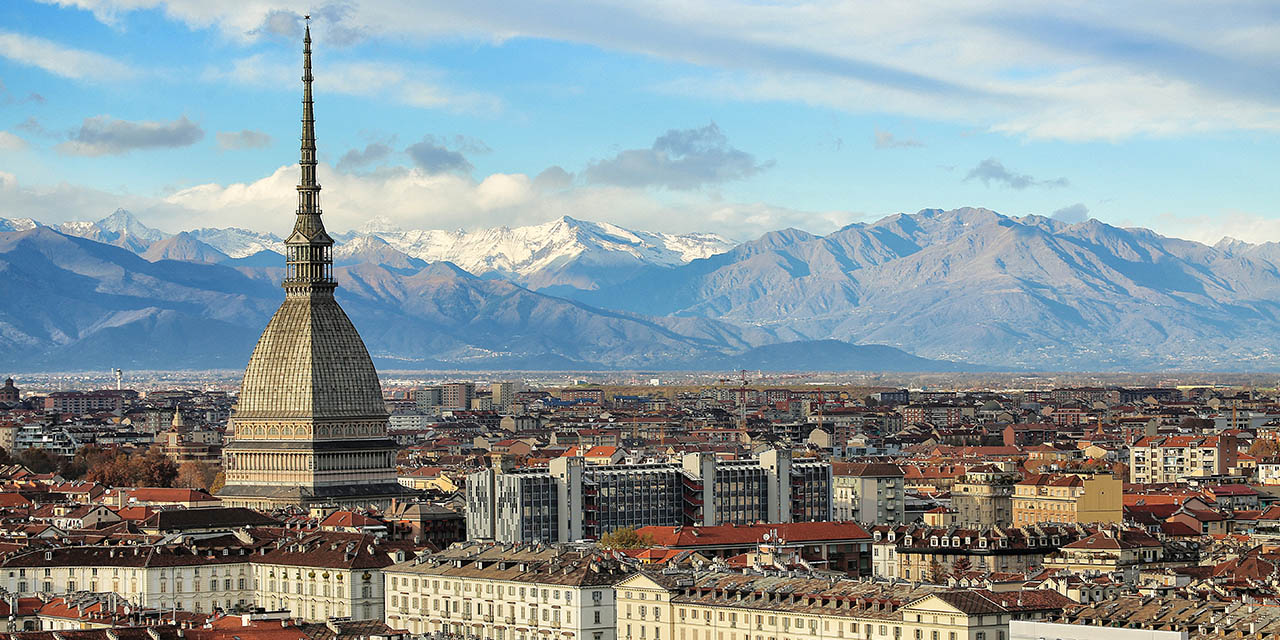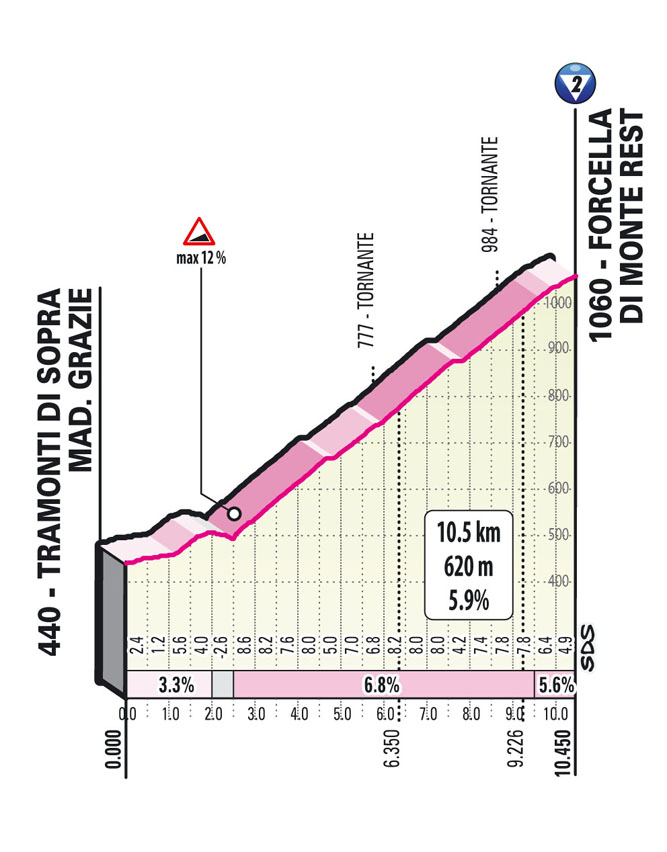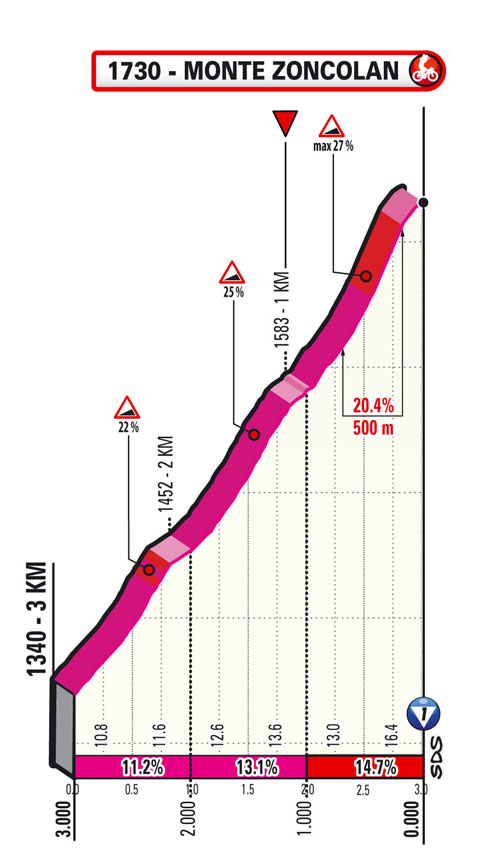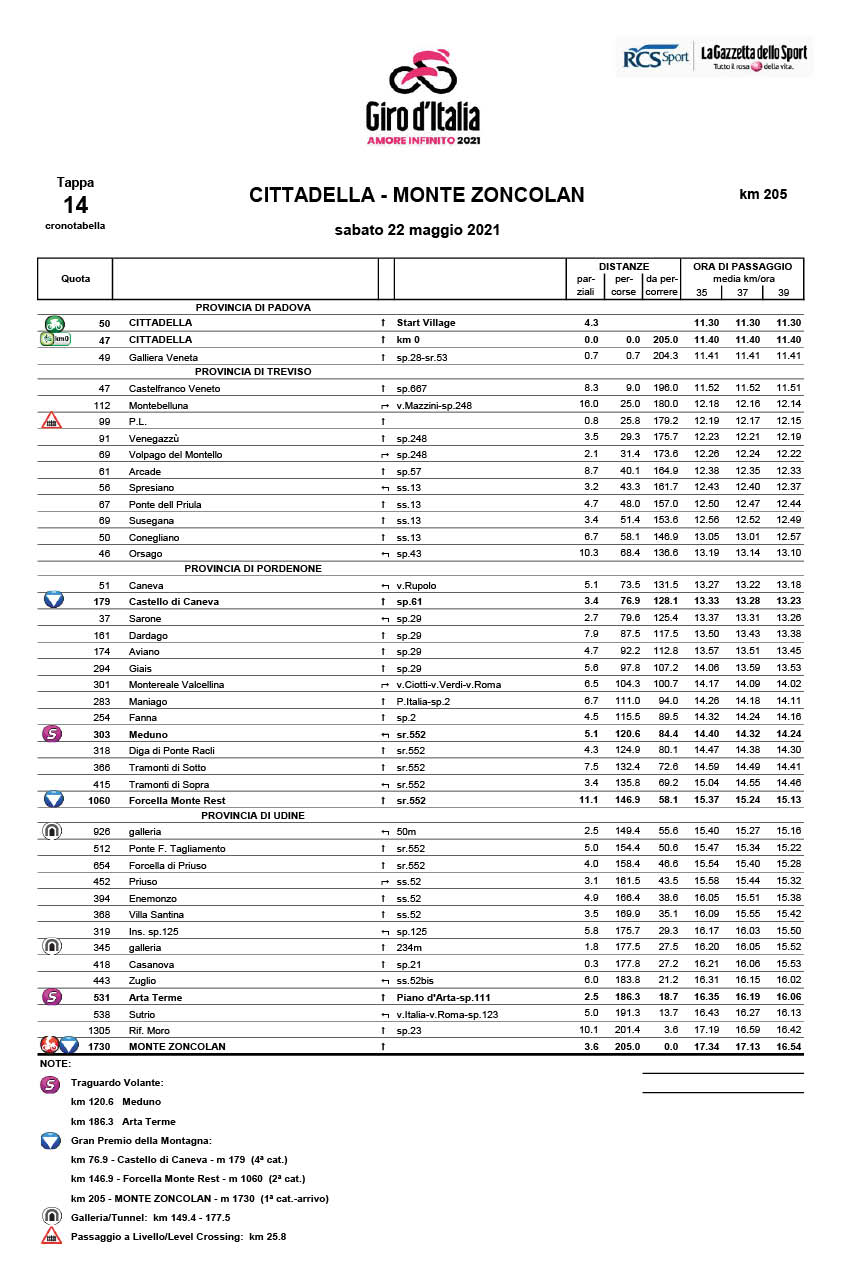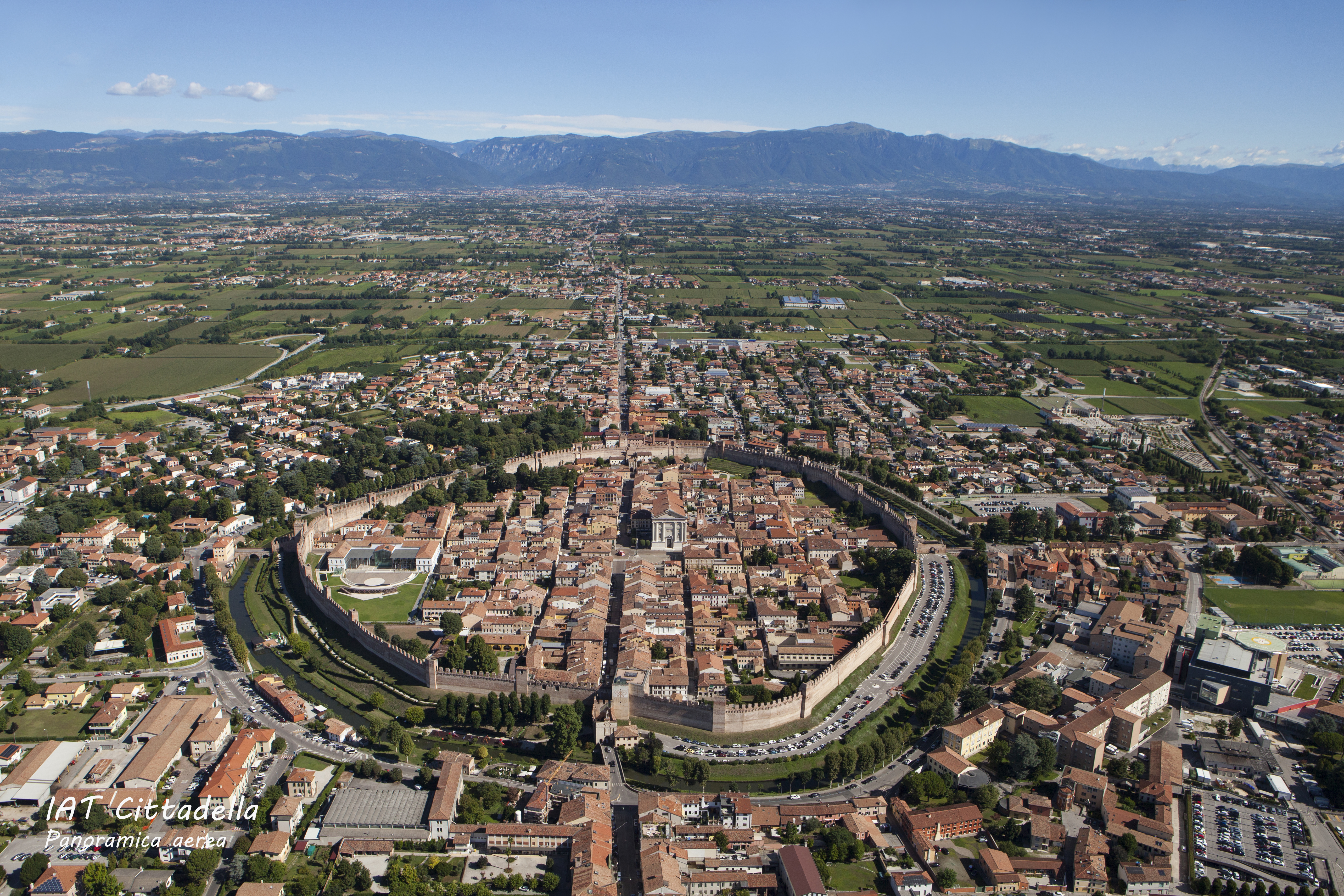profile
map
technical info
This mountain stage is divided into two parts: it starts flat and continues on a slight incline for 130 km, all the way to Monte Rest. The route then weaves through a brace of hairpins, on narrowed roadway, both on the way up and on the way down. After going back on broader roads in Priuso, the route passes Tolmezzo and Arta Terme, reaching the foot of the closing climb. The first 11 km ascend in hairpins, on wide roads, with gradients around 7-8%, whereas the last 3 km are very demanding.
Final kilometres
The last 3 km rise sharply on narrow road with only a few bends, and gradients often exceeding 20% (averaging 13%). The pitch over the final kilometre largely hovers around the 18% mark, with gradients exceeding 25% and topping out at 27% both along the hairpins and in the final stretch. The last 50 metres are on tarmac road and on a slight incline.
start / finish
climb detail
final kilometres
itinerary timetable
tourist info
Host city:
Cittadella
Come and visit Cittadella, a splendid medieval walled town. It was founded in 1220 when Padua decided to build a fortified castle “ex novo” in the central Venetian plains in order to protect its country borders.
Cittadella is the only walled city in all of Europe to have a medieval, elliptical, fully walkable Parapect Walkway.
The Walls can be visited with a panoramic walk at 15 meters high, a unique experience of “Walking on History”.
The town suffered the terrible domination of the local lordling Ezzelino III of Romano, who had built in 1251 the “Torre di Malta”, mentioned by Dante in the Divine Comedy, as a horrible prison for his enemies.
In 2020 Cittadella celebrated the 800th anniversary of its foundation.
Gastronomy
In Cittadella and the surrounding area, there is great respect for ancient culinary traditions, the main influence on the kitchen coming from rural life and countryside. Polenta in all its possible forms plays the leading role: yellow, white and even sweet cake “La polenta di Cittadella” a typical dessert with origins dating back to the 1850’s.
Traditional Venetian dishes from surrounding areas have influenced the Cittadella kitchen, for example, the use of chicory and baccalà (a salt-cured cod).
The best known first courses are “risotto ricco alla Padovana”, rich Padovan rissoto, “il risotto con asparagi” asparagus risotto, the typical “Pasta e Fagioli” pasta and beans, “bigoli all’anitra” thick spaghetti with duck sauce and of course all the other fantastic homemade pastas.
Second courses of meat offer typical rural flavours, like “il cappone alla canevera” (boiled capon) and fish, mostly fresh sturgeon and trout, that are fished in the lakes next to the Brenta river.
In several towns surrounding Cittadella the millennial-old cheesemaking tradition is continued and the flavourful Grana Padano and Asiago produced. Here are some DOP (Protected Designation of Origin) products made in the Cittadella region: yellow and white polenta, Biancoperla corn flour, Montasio cheese, asparagus from Fontaniva, San Martino di Lupari nougat, Pinza cake, the typical cake “La Dama dei Carraresi”.
Drinks
For centuries Padova has been known for its award winning wine, it was exalted by Petrarca and Ruzzante and the vineyards on the Euganean and Bagnoli hills are now cultivated by the experienced wine growers of the DOC Wine Consortium.
Brugnolaro grappa (grape-based pomace brandy) is produced directly in the walled city.
A typical aperitif that can only be enjoyed in Cittadella is the “Mezoevo”: made up of Strega liqueur, “Mezzo e Mezzo” Nardini, soda water and fresh mint leaves, it is dedicated to the writer Hemingway who came to Cittadella to drink Strega liqueur during his service in the First World War.
Main sights
Cittadella Walls and the Parapet Walkway
Cittadella is the only walled city in all of Europe to have a medieval, elliptical, fully walkable Parapect Walkway.
The Parapet Walkway is 15 meters above the Walls of Cittadella. It was the ancient guard walkway that was used to defend the city from above in case of enemy attacks. The recent restoration work has made the historic walkway safe for the public and it is an excellent opportunity to explore the town from a new and attractive perspective a unique experience of “walking on history”.
The visitors’ route is almost two kilometers long and along the way Museums and Rooms can be visited: the re-enactment rooms and medieval set-up in the Casa del Capitano. Also inside the Tower “Torre di Malta” you can visit the almost thirty meters high panoramic terrace view, the Siege Museum and the Civic Archaeological Museum. From above the landscape sweeps over the surrounding countryside, you can admire the Euganean Hills, the Berici Mountains, the Pedemontana with the walled cities of Marostica and Asolo, and Monte Grappa.
Cathedral and Cathedral Museum
The Cathedral, in neoclassical style, was built starting from the end of the 1700s by three famous architects one of whom, Domenico Cerato, also designed Prato della Valle in Padua.
Behind the Church you can find the Cathedral Museum which contains important paintings including “Supper in Emmaus” by Jacopo da Ponte, “Lamentation over the Dead Christ” by Andrea da Murano and “The Flagellation” attributed to Palma il Giovane. There is also a very rich and heterogeneous heritage of sacred objects for liturgical use like altarpieces and gold works as well as statues and inscriptions.
Palazzo Pretorio
This large building is situated along the road near the Treviso Gate, the Eastern gate. It was once
the Governor’s residence where the Governor or podestà sent out by the City of Padua – and from
the 15th century on by the Republic of Venice – lived. Its striking interior contains faux tapestry
decorations in vertical stripes, polychrome friezes, round portraits and medallions. The main portal
in red marble with a St. Mark’s lion and medallions with portraits of Pandolfo and Carlo Malatesta
who were lords of Cittadella is also worthy of note. This recently restored building currently contains the Pretorio Onlus foundation which organizes national and international art exhibitions.
The Theatre
The Theatre is situated along the street to the Vicenza Gate. It was designed by Giacomo Bauto
in 1817 and completed by Francesco Cibele. Its elegant neoclassical façade is attributed to
Giuseppe Japelli whose works included the famous Caffè Pedrocchi in Padua. The theatre was built to 19th century canons with an entrance-hall, a semicircular hall with stage, three rows of boxes and
a former smoking hall. Its magnificent frescoes represent flowers, cupids and allegorical figures
and were done by Francesco Bagnara, a stage designer and painter to whom the decorations in
Venice’s La Fenice are also attributed.
Monte Zoncolan
Overview
Sutrio is located in Valle del Bût, one of the Carnian valleys, described in Carducci’s poetry, only few kilometers from the Austrian border. “O noci della Carnia, addio!” the poet wrote greeting this verdant emerald-coloured land, rich in fragrant alpine flowers and silvery water. Sutrio constitutes one of the best-equipped ski areas in Friuli Venezia Giulia thanks to Mount Zoncolan. The village presents itself as a traditional alpine suburb, made of cobbled streets and ancient houses characterized by wooden and stone-built open galleries and balconies. Sutrio is known as “Paese dei marangons” because of its carpenters’ expertise in woodworking. Together with the main village, the suburb includes the localities of Noiaris, Priola and from April 2009 the Zoncolan locality, popular ski destination and challenge for cyclists. Sutrio’s city centre is characterized by the presence of wooden sculptures and several artisan workshops that organize laboratories for the valorization and the teaching of the wood and the textile processing, undisputed protagonists together with the local cuisine of the numerous festivals and events that take place every year.
Speciality food
Cjarsons: it is a main course typical of the Carnia region. They are dumplings filled with wild herbs, raisin, cinnamon and potatoes. The mixture is very easy, made using flour and water. The dish is seasoned with melted butter and grated smoked ricotta cheese. In the Carnian valleys there are many current varieties (more than thirty), different for size and ingredients.
Pastorut: traditional cheese from “Caseificio Sociale Altobut”. It’s a niche product exclusively made by alpine whole pasteurized cow’s milk. It’s a fat and soft cheese, the production of which requires a significant manual intervention and control. Thanks to its unique taste, harmonious blend of sweet and spicy, it was awarded at the 8th national cheese contest “Infiniti blu” promoted by Slow Food Gorgonzola of Milan with the license plate of excellence ranking among the best 8 blue cheeses in Italy.
Local trout: the agricultural society “La Trute” is specialized in salmon trout and brook trout breeding in its own breeding facility powered by spring water coming from the mountains situated around Mount Zoncolan. Besides the direct sale of the products fished, the enterprise has embarked on a path of multifunctionality specializing in the production of hot smoked salmon trout, in the preparation of sliced fillets of trout and trout burgers. These preparations got the enterprise prestigious awards both in a national and international context over the past few years.
Cured meats: authentic flavors, cured and smoked meats according to the Carnian tradition in the butchers of the village: “Macelleria Piazza” and “Vecje Becjarie”. During the festival “Fums, profums e salums” Sutrio’s suburb realizes a gastronomic tasting of meats of the territory.
High-quality eggs: in the meadows of the fraction of Noiaris the agricultural enterprise “Nearhof” rears his hens outdoors. To produce high-quality eggs on a small scale to offer on the local market is the challenge that Nearhof has undertaken. This is how Near ûfs are born, which are eggs from hens reared outdoors in Carnia.
Drinks
Artisanal beer from the independent alpine brewery “Bondai”, situated at the foot of Mount Zoncolan. Ingredients researching, quality and creativity are the key aspects that define an artisanal beer. Drinking an artisanal beer means to enjoy a singular gustatory moment, that recalls the beauty of a unique and close to the territory product.
Main sights
Nativity scene of Teno: the nativity scene is an extraordinary example of local artisanship result of the patient thirty-year work of Gaudenzio Straulino, called Teno, who for nearly 30 years has expanded and perfected masterpiece enriching it with details all strictly in wood. Built with precision and accuracy, the Nativity scene of Teno recreates the life inside Sutrio’s suburb, so that it can be considered a miniature ethnographic museum which enchants all the visitors.
Textile and wooden artisan workshops: where unique pieces of hand-made carving and embroidery can be found
Chiesa di Ognissanti: it was built on a previous church beginning on 1807, on a design by the architect Francesco Schiavi from Tolmezzo. The church is situated on the same-named hill and was decorated in 1925 by Giovanni Moro. Chiesa di Ognissanti preserves some wooden altars preciously craved, including the largest, work of the sculptor Eugenio Manzani from Pieve di Cadore, dating back to 1771.
Chiesa di san Nicolò: located in the emerald-coloured countryside of Sutrio, it was built before 1327 on the remains of a previous sacred building, blessing the surrounding landscape and situated near the road leading in the direction of Cercivento and Valcalda. Worthy of mention within the church Chiesa di san Nicolò is also the harmonium of 1752, built by an unknown author but probably of the Venetian School.
Mount Zoncolan: important winter ski area of the region, well-known by cycling enthusiasts, Mount Zoncolan is renowned especially for the event “Giro d’Italia”. The climb from the slope of Ovaro is considered the hardest climb in the world because, although not that long, has an average gradient of 12% and a maximum gradient of 22%. Gradients so constant and high are not found in any other climb in Europe. The route from the Sutrio side is the twin brother of that of the Ovaro slope. Characteristic of the eastern side from Sutrio is the discontinuity of the slopes: hard strokes are alternated with sweet ones. Over the last 3500 meters the average climbing is 13% with peaks 20 % higher in the last ramp of 700 meters.
Events and exhibitions:
“Fums, Profums e Salums”: norcina tradition between past and present, first Sunday of March
“I Cjarsons”: Carnian tradition, first Sunday of June
“Fasìn la Mede”: festival of hay, last Sunday of July, event during which the haymaking works are recalled on Mount Zoncolan, at 1300 meters high
“Magia del Legno”: first Sunday of September, celebrates one of the most important activities of the suburb, the woodworking.
On the second Sunday of October“Farine di Flôr”: mills, flour and specialities of Carnia territory.
During the Christmas period (from the Sunday before Christmas to the Epiphany) takes place “Borghi e presepi”, exhibition of artisanal nativity scenes set up in courtyards, cellars and loggias.











